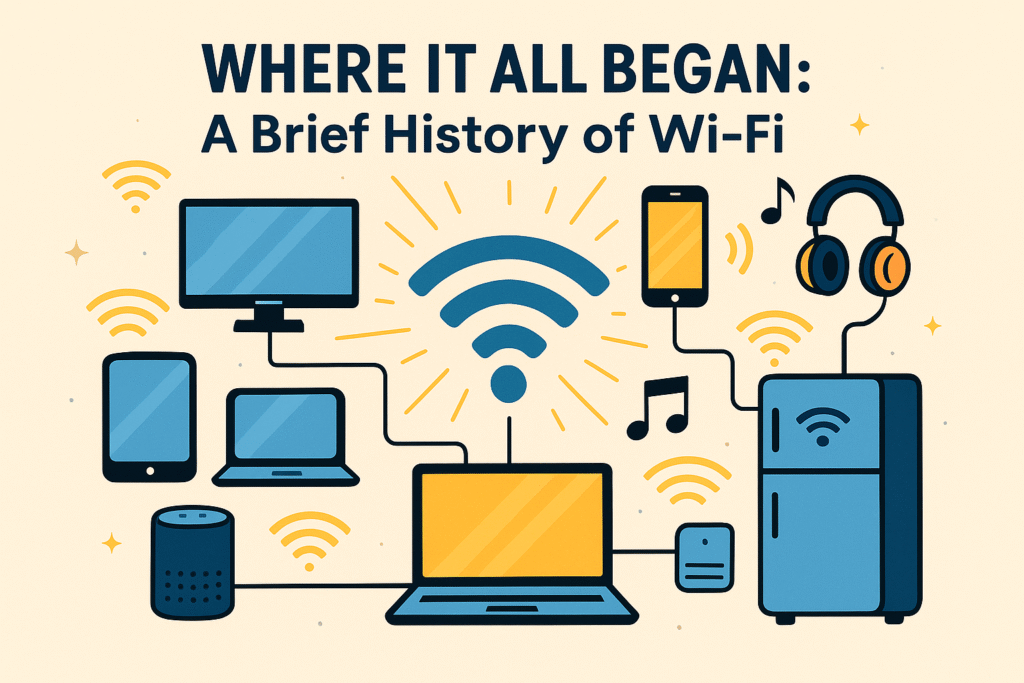Where It All Began: A Brief History of Wi-Fi
In today’s fast-paced digital world, staying connected is everything and Wi-Fi makes that possible. Whether you’re scrolling through social media, binge-watching your favorite series, attending online classes, or working remotely, Wi-Fi is the invisible force keeping you plugged into the world.
But have you ever stopped to wonder how Wi-Fi works or where it all began? Let’s explore the incredible journey of Wi-Fi from its invention to the super-fast, next-gen networks we rely on today.
A Quick Look Back: The Birth of Wi-Fi
The story of Wi-Fi started back in 1997, when the Institute of Electrical and Electronics Engineers (IEEE) introduced the 802.11 standard. This defined how wireless devices could connect to each other — basically, the rulebook of wireless networking.
Then, in 1999, the term “Wi-Fi” was born, thanks to the Wi-Fi Alliance, an organization created to promote wireless technology and ensure that different devices could connect smoothly.
Fun Fact: “Wi-Fi” doesn’t stand for anything. It was just a catchy name, inspired by “Hi-Fi” (High Fidelity), used in audio tech.
So, What Is Wi-Fi Exactly?
In simple terms, Wi-Fi is a wireless networking technology that allows your devices like smartphones, laptops, tablets, and even smart home gadgets to connect to the internet without using wires.
It works using radio waves, a type of invisible electromagnetic radiation, to transfer data between your device and the router, which is connected to the internet.
How Does Wi-Fi Work? A Simple Breakdown
Here’s how Wi-Fi functions, step by step:
1. Radio Waves
Wi-Fi uses radio waves to send and receive data. These waves are similar to those used in radio and TV broadcasting, but they have shorter wavelengths.
2. The Router
A Wi-Fi router is like the heart of your wireless network. It takes internet data from your broadband connection (usually through an optical fiber cable connected to an OLT – Optical Line Termination) and converts it into a wireless signal.
3. Access Points
In large areas like office buildings or campuses, Wi-Fi access points are used to extend the coverage of the network.
4. Your Devices
Devices like laptops, smartphones, tablets, TVs, and even smart fridges have built-in Wi-Fi adapters that connect to the router’s signal to access the internet.
Frequency Bands in Wi-Fi: What’s the Difference?
Wi-Fi operates on different frequency bands (Routers), and each comes with its own strengths and weaknesses.
Here’s a breakdown in table format:
| Feature | 2.4 GHz | 5 GHz | 6 GHz | 7 GHz |
|---|---|---|---|---|
| Range | Long range, penetrates walls better | Shorter range | Similar to 5 GHz but more channels | Even shorter; still under testing |
| Speed | Slower speeds | Faster and suitable for HD streaming | Very fast; low interference | Super-fast, still experimental |
| Interference | High (many devices use this band) | Low | Very low | Very minimal |
| Bandwidth | Limited | More non-overlapping channels | Even more channels | Massive potential |
| Device Support | Widely supported | Most modern devices | Only newer models | Limited, for future tech |
| Best Use | General browsing, smart home | Gaming, video calls, streaming | High-speed offices, 5G homes | Advanced labs, future-proof zones |
The Big Wi-Fi Impact: What a Change, What a Revolution!
Wi-Fi hasn’t just made the internet wireless — it has transformed how we live, work, play, and learn. Let’s look at how:
1. Convenience & Mobility
Forget cables! With Wi-Fi, you can move around freely while staying connected — at home, in a café, or even on a beach.
2. Blazing Fast Speeds
Modern Wi-Fi can deliver gigabit-speed internet, letting you download large files, attend HD video meetings, and stream 4K content without buffering.
3. Entertainment On-Demand
From Netflix to YouTube and online gaming, Wi-Fi powers the world of entertainment right at your fingertips.
4. Work from Anywhere
Wi-Fi makes it possible to work remotely from any location within range — a major plus during and after the COVID-19 pandemic.
5. Boosts Productivity
Employees and students can multi-task and collaborate online using various devices on the same Wi-Fi connection.
6. Security with WPA3
Modern Wi-Fi networks are more secure than ever, thanks to features like WPA3 encryption. Only devices with the correct password can access the network.
7. Helps Businesses Grow
From cafés to libraries, offering free Wi-Fi encourages customers to stay longer, increasing customer satisfaction and sales.
The Global Wi-Fi Ecosystem
Did you know?
- As of 2024, over 22 billion Wi-Fi devices were in use globally.
- Public Wi-Fi hotspots are now available in parks, stations, airports, and even some trains.
- Countries like India are pushing for affordable and rural broadband access using public Wi-Fi under initiatives like PM-WANI.
Experiencing the Future of Wi-Fi
Wi-Fi technology continues to evolve:
- Wi-Fi 6 and 6E bring higher speed, better stability, and support for more devices in crowded places.
- Wi-Fi 7 (expected soon) will support super-high-speed connections and ultra-low latency for VR, AR, AI, and future smart cities.
- Seamless integration with 5G networks will deliver a hyper-connected world where cars, homes, appliances, and wearable devices all stay online 24/7.
Final Thoughts: Future in Your Hands
From bulky wired modems to compact wireless routers, Wi-Fi has come a long way. It’s no longer just a technology, it’s a lifestyle.
Whether you’re attending a Zoom meeting, uploading videos to YouTube, or asking your smart assistant to play your favourite song — Wi-Fi is making it happen.
So the next time your Wi-Fi drops for a second, take a moment to appreciate the power of invisible waves that connect your entire world.
By Himansh Kumar | June 22, 2025






